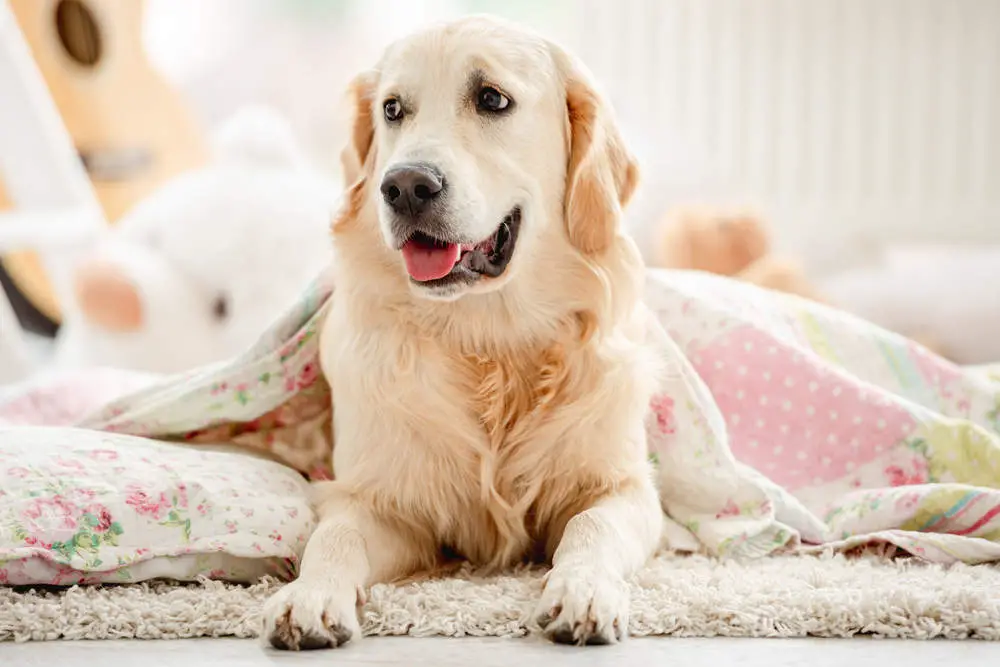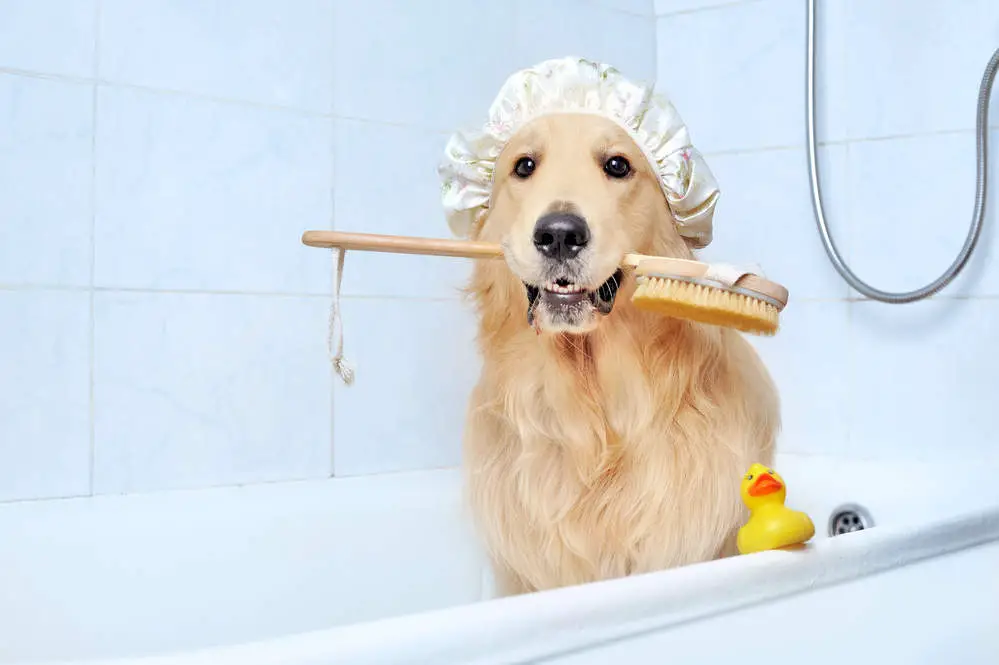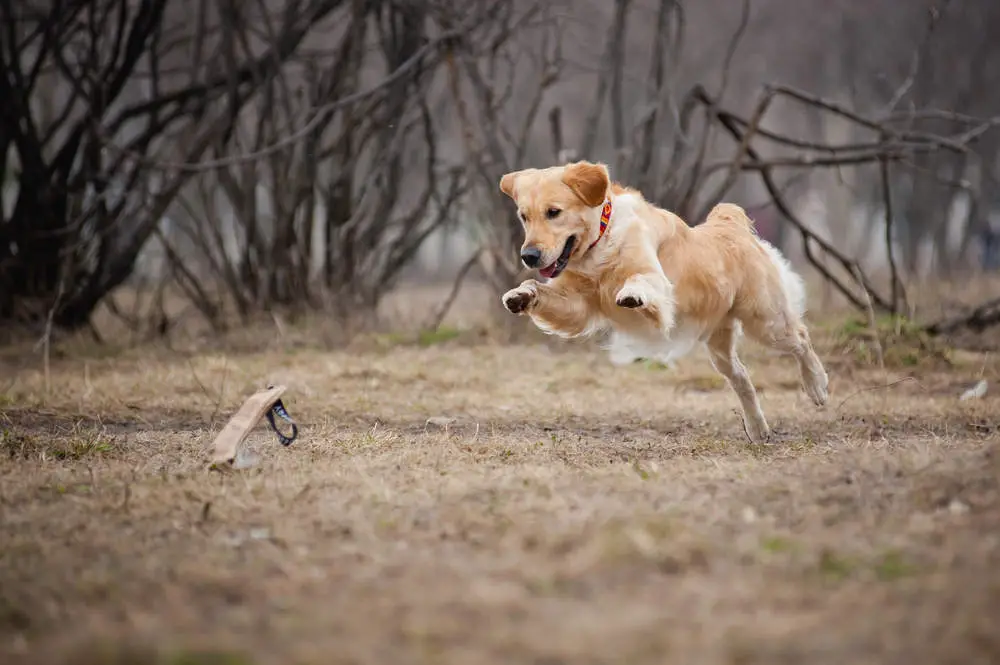
Who has watched the Air Bud series and not cooed at the dogs (or buddies) shooting hoops in style and playing basketball? The fluffy dogs totter and waddle about on screen and are adorable to look at. Some people may have even come back home and wanted to adopt Golden Retriever puppies.
Golden Retrievers seem to be the perfect breed of dogs to be cast in such a film. What’s more, this is not entirely a work of fiction either since the franchise was based on a real-life dog who played a variety of sports. He stars in the series as Air Buddy.
Air Buddy’s proficiency at the game is proof of how intelligent Golden Retrievers are and how well they are able to follow instructions. Golden Retrievers are well-built, medium-sized dogs who have a luscious golden double coat. Their coat is also water repellant, allowing them to survive in different types of weather. When they run, they have a strong and powerful gait, though, of course, their eyes always remain intelligent and friendly.
The eyes alone are not what makes a Golden Retriever friendly. They have great personalities that love to be around people and are especially good with kids. They make for wonderful pets, though they do need a lot of space and may not be the best option for apartment living. The following is a brief profile of the Golden Retriever dog breed.
Origins
From the term ‘retriever’ in their name, you may have guessed that the breed was originally bred to be a hunting dog of some kind. They originate from Great Britain and they are especially useful bird dogs and were popular for hunting waterfowl. This means that they are excellent swimmers and make for great companions on camping and hunting trips.
They were first bred in the Scottish Highlands during the Victorian Era in the 1800s. One of the early developers of the breed, Dudley Marjoribanks, was looking for a dog who would be able to adapt to the wet and rainy weather of the Highlands.
Marjoribanks maintained a record of the process of breeding between 1840 and 1890. He is said to have crossed his Yellow Retriever with the Tweed Water Spaniel, a breed that is now extinct. Genes from the Irish Setter and Bloodhound were also added to this breed.
Some believe the breed also has strains of Newfoundland, though not how the dog is known to be today. Retrievers have been around for so long, it is difficult to pinpoint its exact parentage. What is certain though, is that they are strong dogs that are great swimmers and have a water repellent coat that also enables them to endure cold waters.
Related: Can Golden Retrievers Tolerate Cold Weather?
This is also the reason your Golden Retriever puppy may go chasing after birds and squirrels in your backyard. Even if you are not bringing them up as a bird dog, the instincts they were born with will remain. It is, therefore, important to teach them from an early age that they should not chase after birds by labeling it as undesirable behavior.
They first appeared on the dog show circuit in Great Britain in 1908 and gradually made their way to the United States via Canada around the same time. It was in the 1970s that the breed became especially popular in the United States, owing largely to President Gerald Ford and his pet Golden Retriever named Liberty.
Related: Do Golden Retrievers Bite?
Golden Retriever At a Glance
The American Kennel Club has a strict criterion for the general appearance of Golden Retrievers. The AKC sees a well-bred Golden Retriever to be short legged, elegant and active. It should not be clumsy and should have a powerful gait. It should have a confident personality and should be eager and alert. It is also important to show that the Golden Retriever is a hard-working dog since it is primarily a hunting dog. It is counted under the Sporting Group of dogs.
The following are some of the physical details you may notice in a Golden Retriever breed:
Weight: 63-70 lb (males); 55-63 lb (females)
Height: 58-62 cm (males); 53-55 cm (females)
Coat: Straight, medium-length water repellent double coat. The coat is usually a variation of golden, though it may be darker or lighter.
Muzzle: Straight
Ears: Floppy
Related: How Much Do Golden Retrievers Cost?
Golden Retrievers as Pets
As has already been made abundantly clear, Golden Retrievers make for incredible pets. They have a strong and jubilant personality, but much of what they do is to please the people they love. They respond well to love and patience.
They are also energetic dogs that need a lot of space to run around. Caring for them also means ensuring they get the right kind of exercise and also teach them desirable manners that will tone down some of their excitability. The following are things you will need to know about taking care of a Golden Retriever pet:
Personality
Golden Retrievers have a vibrant and playful personality. They are good tempered and are usually not moody as a breed, though individual dogs may differ. Golden Retrievers tend to be very affectionate and friendly. They have high emotional intelligence as well as incredible agility, given that they are bird dogs and great swimmers too. They are great to have in a home with kids and even with other pets.
They are also extremely loyal pets and will go to great lengths to please people, especially their owners. This is, perhaps, also the reason they are so good at obedience training and are great at picking up commands. They are hard-working dogs and will do what is asked of them, though they are not good guard dogs. They are friendly even with strangers and are not likely to bark, so do not expect them to be good watchdogs.
Related: Can Golden Retrievers Be Aggressive?
Grooming

Like all dogs, Golden Retrievers also shed, though perhaps not as not much as huskies or other dogs that blow their coat. However, they do have a medium coat length, which means that you cannot escape the shedding. They are also light-haired dogs so you are likely to see hair in different places.
Since they have a double coat, they are seasonal shedders. At least twice a year, they will shed heavily and through the rest of the year, they shed continuously, though in moderation.
Related: How Fast Does a Golden Retriever’s Hair Grow?
A way to manage the shedding is to brush their hair weekly. Use a slicker brush and remove hair by brushing twice a week. Brushing removes the loose hair and allows you to collect it in one place before it sticks onto upholstery and other parts of the house. During the seasonal shedding period, you will need to brush their hair out every day as the amount of shedding will be quite heavy.
Make it a part of their routine and select a designated part of the house to do the brushing so it does not get all over the house. A bath is also a good way to loosen the hair out, though retrievers do not require too much maintenance in terms of frequent baths. If you do think bathing them will help to brush out the loose hair, do so only after their coat has dried completely.
Related: When Do Golden Retrievers Stop Teething?
Deshedding Tools
While regular brushing should take care of most of the shedding problem, if the shedding is getting out of control you can also try some deshedding tools. In addition to a slicker brush, you can use an undercoat rake to loosen the hair out so you can brush them out easily.
You can also research various kinds of rubber grooming brushes for your goldie which are great for massaging and improving circulation, as well as removing loose hair during shedding.
Having said that, there is no way you can prevent your Golden Retriever from shedding hair, so if this is a problem you cannot reconcile with, consider getting a pet that sheds less. If you notice your Golden Retriever losing hair in tufts and patches, that could be a symptom of a problem and you should have them checked out.
Related: Why Is My Golden Retriever Scratching So Much?
Should You Trim Your Golden Retriever’s Hair?
You absolutely must not trim your Golden Retriever’s hair. No long-haired dog should ever have their tresses chopped off unless it is for a medical reason or they need to go in for surgery.
Well-meaning owners may often think that their pooch will be more comfortable in the summer months if they have a thinner coat of hair. However, this does more harm than good. The double coat is there for a reason. It protects the dog from infections and allergies of various kinds.
Dogs have their own mechanism of shedding hair and thinning the coat out when the temperature rises. When you intervene, you are intervening with the natural system of their bodies and can cause serious harm.
Besides, dogs do not feel the heat in the same way that humans do. They do not perspire the way human beings do, so if you think the thick coat makes them uncomfortable in the summer months, that is not the case. Dogs cool down by panting instead so their coat need not be a concern.
Related: When Do Golden Retrievers Go Into Heat?
Training and Exercise

While Golden Retrievers are extremely friendly and amicable dogs, they need to be socialized early and trained as pups. They need to be taught to control their excitement when they see a baby, another pet or even when they greet you at the door when you come back home. Friendliness can also become over-friendliness and may not sit well with some of the guests who come home or even with strangers at a park.
Early socialization involves gradually exposing your puppy to different people and places. You can even enroll them in a class, there are plenty available in most areas. Obedience training is also a good way to increase the bond between the puppy and its owner. As mentioned before, they are eager to please so obedience training is a good opportunity for them to show their loyalty to their owner. Nothing makes them happier than when you reward them for their good behavior.
Since they are bird dogs, it is also apparent that they need a lot of exercise. They are extremely active dogs that will react to stimuli rapidly and for them to stay as sharp as they are, they need plenty of exercise. If they do not get the required amount of exercise, they may get restless and be destructive. If you live in an apartment and do not have too much yard space to run around in, it is important to take the dog on walks twice a day. Golden Retrievers also make for great companions on hikes and trails.
Related: Can Golden Retrievers Run Long Distances?
Health and Nutrition
Golden Retrievers are well-built dogs, but they can be prone to a few different health problems. Since they are not small or light dogs, they do tend to develop arthritis or other joint conditions as they grow older. If they have been bred responsibly, however, they should not be prone to physical conditions like hip and elbow dysplasia.
Some of the other conditions Golden Retrievers could be vulnerable to are eye conditions like juvenile cataract, progressive retinal atrophy, etc. They could also be prone to heart conditions such as subvalvular aortic stenosis. It is extremely important to check the inside of their ears weekly and look out for symptoms of an infection. You may also want to brush your Golden Retriever’s teeth regularly.
Related: Why Does My Golden Retriever Sleep So Much?
In addition to carrying out all these health screens, it is also important to take care of your dog’s nutrition through their diet. Ensure your goldie is getting plenty of proteins and Omega-3 in their diet. This will keep their coat shiny and golden. Golden Retrievers are also prone to putting on weight so you should be careful about overfeeding them, especially if you notice signs of obesity. You should keep an eye on calorie consumption and do not change any diet drastically.
Obedience training does involve giving your pooch treats. However, try to do so in moderation or find a treat that has fewer calories. Certainly, avoid giving your dog sugary treats. You should also not get into the habit of giving your dog table scraps, especially if you are enjoying a meal that is high on fat content. Carry out thorough research on what kinds of human foods are suitable for dogs, especially for Golden Retrievers.
Related: Do Golden Retrievers Drool a Lot?
Types of Golden Retrievers
There are a few different types of Retriever dogs, of which Golden Retrievers and Labrador Retrievers are two of the most popular. In addition to these two, there are four other types of retrievers which are Chesapeake Bay Retriever, Flat-Coated Retriever, Nova Scotia Duck Tolling Retriever and Curly Coated Retriever.
Within Golden Retrievers, there are three types though the variations between all three are miniscule. Still, it is important to flag this difference off. The three types of Golden Retrievers are:
- Canadian Golden Retriever: Canadian Golden Retrievers, as the name suggests, are popularly bred in Canada. Their hair is slightly shorter and thinner as compared to the other two varieties. The Canadian Retrievers are also taller than the other two types by approximately two inches. However, to the untrained eye, these differences may be negligible.
- English/British Golden Retriever: British or English Golden Retrievers have a long and feathery coat. They tend to have a light golden coat, close to cream. British Golden Retrievers also have a broader skull and a wider muzzle. Their forequarters are more strongly built than the other two types of Golden Retrievers.
- American Golden Retriever: Finally, an American Golden Retriever is the leanest and least muscular of all three types of Golden Retrievers, though the difference is not as stark. They also have a darker coat compared to the other two breeds, though the coat is as long as their English cousins.
Related: Can Golden Retrievers Smile?
Parting Words
From what has been described above, one clear thing is that Golden Retrievers are highly friendly and amicable dogs. They are loyal, they love to be around people and are great pets to have in a family with kids and other pets. Golden Retrievers will go to a great extent to ensure their owners are happy and are eager to please the people they like (which is usually everyone they meet). This also makes them great at obedience training as they respond exceptionally well to rewards and praise.
Despite their friendly nature, it is important to socialize Golden Retrievers early so some of their eagerness to please and show affection can be toned down. They are not necessarily small or light dogs, so when they bound towards anybody with enthusiasm they can be difficult to control. It is, therefore, important to let them know from the time they are puppies that this is undesirable behavior. They must learn to show affection without causing injury.
Golden Retrievers are not difficult to care for if you give them an adequate amount of exercise and keep them active and on a healthy diet. They will prove to be one of the most loyal members of your family!
